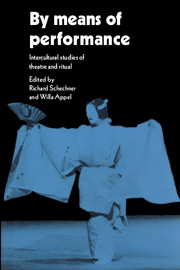Book contents
- Frontmatter
- Contents
- List of figures
- Notes on contributors
- Concerning Victor Turner
- Introduction
- 1 Are there universals of performance in myth, ritual, and drama?
- 2 Magnitudes of performance
- 3 Liminality: a synthesis of subjective and objective experience
- 4 The Yaqui deer dance at Pascua Pueblo, Arizona
- 5 A Yaqui point of view: on Yaqui ceremonies and anthropologists
- 6 Performance of precepts/precepts of performance: Hasidic celebrations of Purim in Brooklyn
- 7 The significance of performance for its audience: an analysis of three Sri Lankan rituals
- 8 What does it mean to “become the character”: power, presence, and transcendence in Asian in-body disciplines of practice
- 9 Korean shamans: role playing through trance possession
- 10 The practice of noh theatre
- 11 The profanation of the sacred in circus clown performances
- 12 Ethnographic notes on sacred and profane performance
- 13 The spatial sense of the sacred in Spanish America and the American South and its tie with performance
- 14 Space and context
- 15 The transformation of consciousness in ritual performances: some thoughts and questions
- 16 Universals of performance; or amortizing play
- Appendix
- Bibliography
- Index
13 - The spatial sense of the sacred in Spanish America and the American South and its tie with performance
Published online by Cambridge University Press: 05 June 2012
- Frontmatter
- Contents
- List of figures
- Notes on contributors
- Concerning Victor Turner
- Introduction
- 1 Are there universals of performance in myth, ritual, and drama?
- 2 Magnitudes of performance
- 3 Liminality: a synthesis of subjective and objective experience
- 4 The Yaqui deer dance at Pascua Pueblo, Arizona
- 5 A Yaqui point of view: on Yaqui ceremonies and anthropologists
- 6 Performance of precepts/precepts of performance: Hasidic celebrations of Purim in Brooklyn
- 7 The significance of performance for its audience: an analysis of three Sri Lankan rituals
- 8 What does it mean to “become the character”: power, presence, and transcendence in Asian in-body disciplines of practice
- 9 Korean shamans: role playing through trance possession
- 10 The practice of noh theatre
- 11 The profanation of the sacred in circus clown performances
- 12 Ethnographic notes on sacred and profane performance
- 13 The spatial sense of the sacred in Spanish America and the American South and its tie with performance
- 14 Space and context
- 15 The transformation of consciousness in ritual performances: some thoughts and questions
- 16 Universals of performance; or amortizing play
- Appendix
- Bibliography
- Index
Summary
Working with the same script, so to speak, and indeed, sharing many words in common, participants in two Christian faiths, the Catholics of Spanish America and the Baptists of the American South, put together action and artifact to construct two distinct senses of the sacred. The sense that the Spanish American Catholics have is that the sacred lies outside the person of the worshiper, while the Southern Baptists, in contrast, locate the sacred inside that person. In one, the communicant reaches out; in the other, the believer listens within.
To achieve their external sense of the sacred the Spanish Americans approach the sacred as individuals approaching factual objects. Conversely, to achieve their interior sense, the Baptists join together as a group. In addition, the individual in the Spanish American iglesia reaches out for the sacred in the context of a hierarchical structure at whose apex resides the Pope in Rome. The Baptists, in contrast, turn inward to feel the sacred's presence in the context of an egalitarian structure that proclaims the independence of each democratically constituted church.
Methodological note
“Spanish American Catholicism“ here refers to the worship participated in by those Spanish speaking citizens of Latin America whose cultural heritage took shape during Spain's conquest of the New World. Excluded are the forms of Catholicism that include many American Indian or African elements and also excluded are the forms of modern worship that reflect contemporary, intellectual trends, such as liberation theology.
- Type
- Chapter
- Information
- By Means of PerformanceIntercultural Studies of Theatre and Ritual, pp. 221 - 235Publisher: Cambridge University PressPrint publication year: 1990
- 2
- Cited by



